Succulents as Low Maintenance Shrubs
BY SHARON REEVE
When you picture a succulent garden, you might be like me and see in your mind's eye many colorful tiny plants in a precious arrangement, but have you ever thought of succulents as shrubs in a low-maintenance and drought-tolerant garden? Many succulents have a neat and tidy domed habit that suits a low-water garden well. These mid-size succulents can perform the role of shrubs with much less water and maintenance. Be sure to have well-drained soil and full sun for these plants. Some of them can tolerate some shade but the colors will not be as intense.
Unlike shrubs, these neatly growing plants are rarely boring green, and come in many interesting colors and shapes. One of the basic tenets of good garden design is a variety of textures, sizes, and colors. Succulents don't rely on flowers to provide interest; they do that all year long with their foliage. You don't ever have to apologize to garden visitors that, "they should have been there last week because the plants were blooming" because the interest is the year-long texture and color of the foliage. With these plants, you can have a beautiful garden 12 months a year.
Additionally, succulents are easy to prune should they get larger than you want. Cuttings quickly and easily make new plants somewhere else in your garden. For example, cut the head off an Aeonium and stick it in the soil, and soon you will have another shrub-succulent. Here are a few of my favorites:
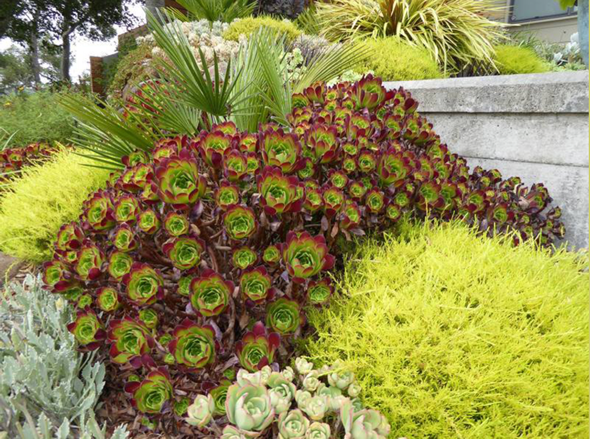
Aeonium 'Jack Catlin' (David Feix )
Several Aeoniums make great succulent shrubs. The rosettes don't collapse in the summer heat like Aeonium arboreum and quickly make an organized dome of heads. In this case, Aeonium 'Jack Caitlin' is a small succulent shrub around two feet tall and wide with gorgeous wine and spring green rosettes. It is a hybrid of A. arboreum 'Zwartkopf' and A. tabuliforme made by John Catlin at Huntington Gardens. This succulent does best in full sun where the colors intensify. Repeat this succulent shrub in several places in your border to create continuity in your color scheme. This is a tough plant that will get by on very little water, even in full sun. Plant with chartreuse plants to pick up the fresh green center. One good pairing is with Sedum x adolphii, a low-growing yellow succulent that varies from chartreuse to golden with orange tips. A. 'Jack Caitlin can tolerate light frosts.
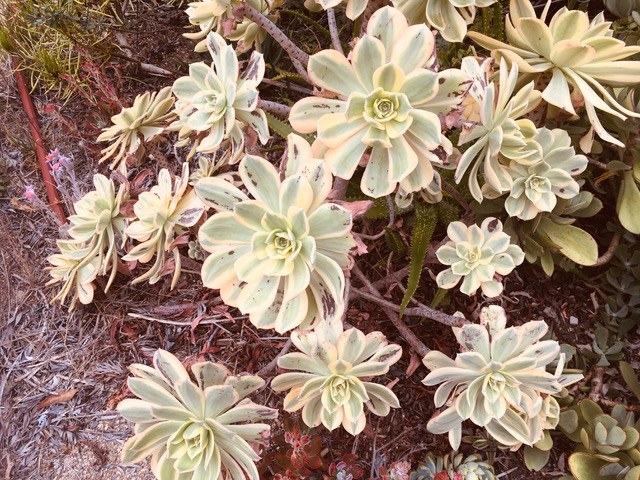
Aeonium ‘Sunburst' (Sharon Reeve)
One of my favorite plants, Aeonium ‘Sunburst’, is a standout for easy care and color. Looking at it, you would think it is a delicate fussy plant, but it is a robust fast grower eager to show off in your garden. Once again, full sun and well-drained soil are required for best results. Skirt this succulent shrub with Senecio serpens for a pleasing combination. The blue of the Senecio serpens picks up the bluish green of the Aeonium. The coral pink stripe of the rosette is more evident in full sun and heat. Interplant with Echeveria 'Mauna Loa' to echo the coral edge of the Aeonium's rosettes. Any coppery succulent will work. You can also use shorter dark red Phormium cookianum. These rosettes are bigger and can get close to a foot across. The rosettes root easily. Even when not watered they will hang out until there is some water to start growing. Aeoniums have a drawback in that stems will die back after bloom, but there are always plenty of rosettes to replace the plant stem that died. This succulent shrub gets about 2 feet high and wide.
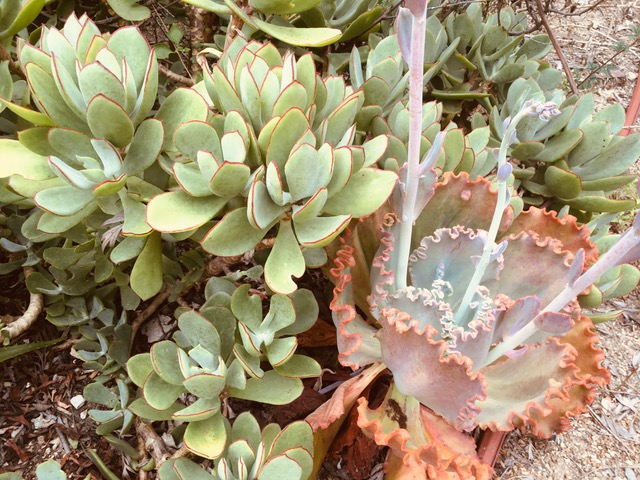
Cotyledon 'Mint Truffles' (Sharon Reeve)
Many of the Cotyledon selections are great succulent shrubs. This one is Cotyledon ‘Mint Truffles’. The foliage is a nice medium green paddle with a red edge leaf edge. It quickly makes a rounded shrub, and like the shrubby Aeoniums, starts easily from pieces of branches. The foliage is chunkier than the well-known jade plant. These are easy plants for drought tolerant shrub forms in a succulent garden. They steadily increase in size and can be trimmed to appropriate size easily, resulting in cuttings for new plants. To keep it smaller, trim off slightly smaller than desired and it will fill back in. Cotyledons are slightly frost tolerant and will defoliate with frost. This plant reaches 2-3 feet tall and wider.
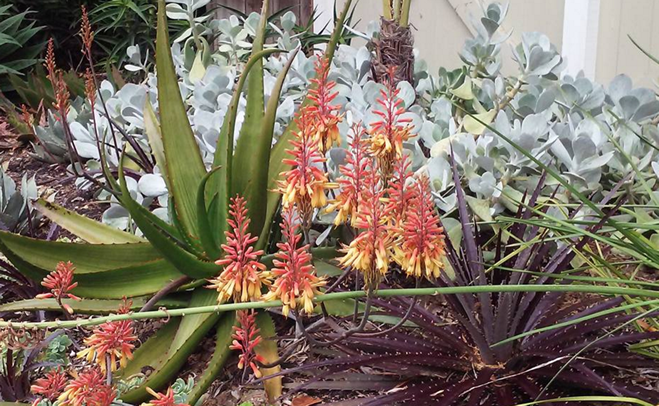
Aloe camperi
There are so many forms of Aloe from groundcovers up to trees. There is a small group of shrub-sized Aloes that offer different textures and foliage colors in the garden border, plus blooms that last a month or more. The Aloe pictured is a species called Aloe camperi. This plant blooms in spring and grows about one foot high and three feet wide. If orange Aloe foliage is desired, plant Aloe dorotheae or Aloe cameronii. These shrubby Aloes have foliage that turns red with heat and drought. This is good to know in Zone 23 Sunset where summers can be challenging for landscape plants. These mid-size Aloes are great as you can have one blooming almost all year with careful selection. They clump and spread to create a small mass that is weed-free and lovely. Another good dense spring bloomer is Aloe 'Moon Glow' with yellow-tipped blooms and bluish foliage. Match this up with blue Senecio serpens and Crassula 'Sunset' to echo the colors.
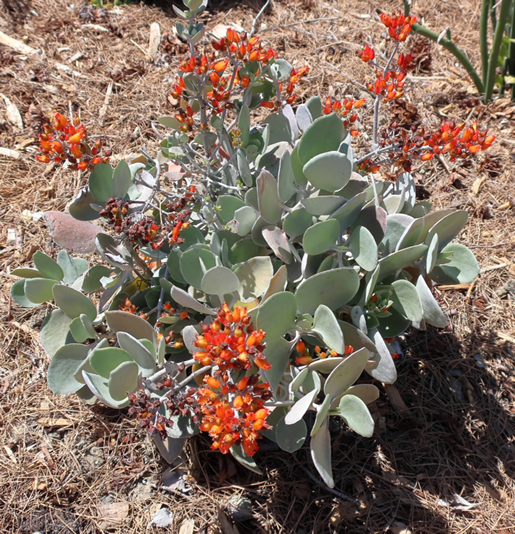
Kalanchoe bractreata (Kathleen Moore)
If you are nuts about white, silver, and blue foliage, like I am, you can find these colors in so many succulents. Kalanchoe bracteata has blazingly white fuzzy foliage. It is absolutely one of the easiest plants to grow. Succulents often have fuzzy white or silver foliage to deal with heat and drought. Fuzzy white leaves keep the full intensity of the sun from reaching the leaves and cool the leaf surface, plus they slow dehydration. Kalanchoe bracteata grows to about two feet tall and wide. It blooms in muted red, attracting hummingbirds. White foliage matches everything and can be happily sited in full sun next to almost any plant. I like to group white or silver foliage together. This plant looks good with another drought tolerant plant called Teucrium marum with silver foliage and purple flowers. Both are easy and drought tolerant. Teucrium marum is a long-blooming plant favored by bees.Hopefully, this article has you thinking about using succulents as shrubs in the garden. Succulents are better than thirsty shrubs because they are drought tolerant and grow densely to choke out weeds. Using medium-size succulents in this way adds interest to the garden with color and texture and is a smart choice to reduce maintenance and watering. With a little planning, you can easily make a satisfying garden composition and you can stand by while compliments come your way.

